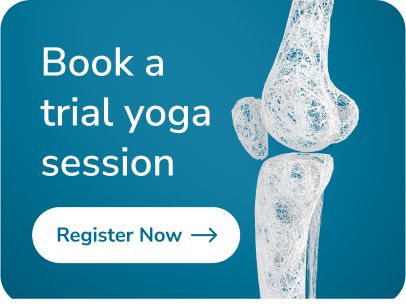Written by Dr Reshma N Babu
Medically reviewed by Dr Naveen Chandran
Updated on February 03, 2025
A Comprehensive Meditation Guide to Maintain Joint Health
Did you know there is a strong connection between meditation and joint health? This informative guide aims to show how meditation practices can positively impact joint health and overall well-being. Let's explore how incorporating mindfulness and meditation benefits for joint health.
Jump to section
- Decoding the Mind-Body Connection
- Why Do We Need Mindfulness Exercises for Joint Health?
- Meditation Techniques for Joint Health - How and When?
- Meditation for Joint Pain Management
- Mind-Body Wellness for Overall Health
- How to Integrate Meditation into Daily Routines?
- Conclusion
Decoding the Mind-Body Connection
Meditation is not just limited to breathing exercises that can help you relax, but it enables you to embrace the beauty of life's journey with much love and happiness. It is the fundamental right of a human being to live a life with full potential, which not everyone will be able to flaunt with grace and ease due to specific health conditions. That's where mindfulness has a role to play. Meditation and mindfulness complement each other and can help you improve your feelings and thoughts around the pain you suffer. Meditation can increase your tolerance to pain and can seed you with positive thoughts that contribute to overall health and vitality.
Why Do We Need Mindfulness Exercises for Joint Health?
Mindfulness exercises help your mind train to live and feel the present moment and not worry about what happened next or earlier. They can help you live the moment while paying full attention to what it is about and help you develop a sense of healing and better tolerance to pain. Joint-friendly meditation practices help reconstruct your approach to seeing the suffering you have been through. Meditation helps positively influence your body's stress response, decreasing the overall severity of the condition.
Can mindfulness help in reducing your joint symptoms?
Studies done among rheumatoid arthritis patients who practised mindfulness suggest that their symptoms decreased considerably.
The following changes were seen in people with RA and joint-related conditions:
- Decrease in pain sensitivity
- Decrease in joint stiffness
- Decrease in inflammatory responses
- Improved sleep quality
- Enhanced mood
Now, let us find out how a meditation technique improves joint health.
Meditation Techniques for Joint Health - How and When?
Meditation techniques help you develop better joint health and decrease the severity of deteriorated joints. They mainly help you improve your pain tolerance and how you deal with your joint conditions.
Let us check out meditation techniques that promote relaxation and ease joint-related discomfort.
| Types of meditation techniques | How does it work? | Benefits |
| Mindfulness meditation |
| This technique helps you with better pain management and stress reduction. |
| Active meditation |
| This meditation technique helps in decreasing the pain sensitivity as it helps in improving your presence of mind and self awareness. |
| Breathing meditation |
| This is one of the basic mindful meditation practices that helps in mood enhancement , stress reduction and thus imparting a sense of well being , reducing the symptoms of joint conditions. |
| Visual meditation |
| It helps to improve pain sensitivity and reduces stress responses that gradually leads to decrease in symptoms. |
| Mantra Meditation/ transcendental meditation |
|
|
Meditation for Joint Pain Management
Before knowing why meditation can help you find the key to relief, it is essential to understand that medications can only treat joint issues. Practising meditation can only help you reconstruct your approach to coping with pain and better-coordinated health management, decreasing the severity of your suffering. Meditation improves the condition, as drugs do not work on your body's stress pathways, but meditation does. Reducing overall pain severity helps you improve the quality of your life.
Joint-friendly Meditation Practices With Yoga
Now let's move on to explore certain yoga practices that help in increasing the sense of awareness and have positive effects on your stress response
- UTTANASANA/STANDING FORWARD BEND
This pose helps deactivate your stress response by stretching the back side of your body, including your back and shoulders, buttocks, back of your thighs, calf muscles, and the soles of your feet. This helps in strengthening your knee joint and increases the flexibility
- UPAVISTHA KONASANA/WIDE ANGLE SEATED FORWARD BEND
This pose strengthens the hamstrings and stretches your back, thighs, and calf muscles, strengthening your knee joint.
- MALASANA/WASTE EVACUATION POSE
This pose stretches the backside of your body, increasing overall flexibility and joint health.
- PASCHIMOTTANASANA/ SEATED FORWARD BEND
This pose helps stretch the muscles of your back, thighs, and calves and improves the flexibility of your backbones. Practising paschimottanasana also helps improve overall joint mobility.
- DHANURASANA/BOW POSE
This super-stretching pose simultaneously improves the flexibility of your knee joints and backbones. It also helps burn calories and manage weight.
- TADASANA/MOUNTAIN POSE
This provides an upward stretch to your body against gravity, strengthening your joints and improving overall flexibility.
- BHUJANGASANA/COBRA POSE
This pose helps simultaneously increase the mobility of your backbone and shoulder joints, improve joint strength, and burn belly fat.
- BALASANA/CHILD POSE
This helps relieve your back pain and relaxes the muscles of your back and thighs.
Mind-Body Wellness for Overall Health
Health is about focusing on what is good for your body and feeding on what helps you balance your mind.
Ayurveda follows the mind-body wellness approach for overall health. Unlike other medical sciences, Ayurveda's disease treatment approach involves practising healthy mind exercises and taking medications. The theory of 'hot ghee and pot' (tap ghatayoriva ago) explains that whatever factors imbalance your mental health gradually deteriorate your physical health and vice versa. So, being healthy is not just limited to the 'body'.
How to Integrate Meditation into Daily Routines?
There are many ways to meditate, but the basic principle involves training your mind to focus on something. Being mindful allows you to sense the moment and feelings without judgment.
You can try meditating by adopting many ways like:
- Practising it on your own
- Seeking professional help from a yoga instructor
- Making use of specific guided apps/YouTube.
Note: Integrating meditation into your daily routines mainly involves finding a place to make you comfortable. Whenever you feel exhausted or stressed out, find yourself in a place that can help you settle down.
Conclusion
Incorporating meditation techniques and mindfulness exercises into your daily routines can help you experience a deeper mind-body connection, reduce joint-related discomfort, and foster overall well-being. As with any wellness practice, it is always encouraged to consult with healthcare professionals for personalised advice and guidance. Get connected with our Nirva health experts now and explore the benefits of practising mindfulness for better joint health.
Frequently Asked Questions
Yes. Meditation can help with better tolerance to pain and improve joint flexibility. Meditation positively affects the stress pathway, which is fundamental in relieving the symptoms where drugs fail to act.
Yes, meditation can help you impart physical and mental benefits to your body, improving overall vitality.
No. Joint pain arises from various common issues that must be diagnosed and treated after seeking professional help. Meditation can only help you improve tolerance to pain but does not treat the real cause of joint pain.
Yes, better stress management can help you manage joint pain better, as it positively affects your stress pathway, decreasing the overall severity of pain.
Dr Reshma N Babu
Dr Reshma N Babu is a passionate, young Ayurveda doctor who strongly believes in sharing the warmth of her knowledge in Ayurveda medicine in caring for people who are suffering from physical and mental imbalances. Dr. Reshma highlights Ayurveda not just as a medical science that cures disease but as a way of living.

8 Effective Face Yoga Exercises to Reduce Marionette Lines Naturally
15 Foods to Avoid with Gallbladder Issues & Best Foods for Gallbladder Health
Understanding Your Gut Type and Its Impact on Health
4 Simple Ways to Manage Hot Flashes at Work
3 Stretching exercises for desk workers - Get Relief from Neck, Back and Wrist Pain









